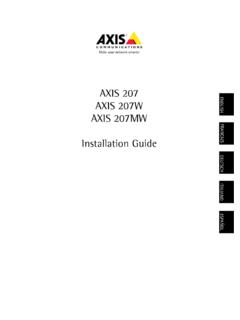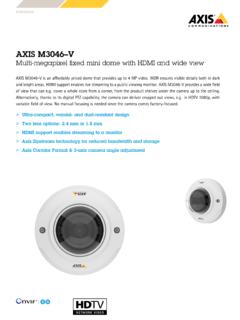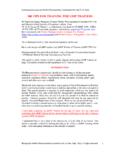Transcription of Perfect Pixel Count - Axis Communications - …
1 ArticlePerfect Pixel CountMeeting your operational requirementsTable of contents1. Introduction 32. Moving into IP 33. Pixel density 44. A simple model 55. Use the model 66. The axis Pixel counter 77. Conclusion 731. IntroductionThis step-by-step guide helps you select the best cameras for your operational requirements and surveillance of industry standards and the complexity of the matter cause many integrators to lose sight of a key prerequisite in any installation: the operational requirements or the true purpose of the this guide, we present the Pixel Density Model a method that allows you to relate the operational requirements of your system to modern surveillance video and IP Moving into IPSelecting the appropriate surveillance camera to fulfill operational requirements has always been a the introduction of IP cameras, and especially through the development of megapixel and HDTV cameras, the need has emerged for a new way to determine how to meet operational requirements.
2 In these six steps, we describe a model to relate operational requirements to modern video and IP recommending cameras and discussing what is the best camera on the market, it is easy to focus on datasheets and technical specifications. This causes many integrators to lose sight of a key prerequisite in any installation, namely the operational requirements or the actual purpose of the when surveillance was all analog, selecting a camera to match an operational requirement was mostly about selecting the appropriate lens since there wasn t a wide variety of resolutions to choose from.
3 Most CCTV systems are designed to monitor human behavior, so the human body was used as a yardstick. In order to differentiate between diverse types of scenarios, various categories were es-tablished based on percentage representation of the height of a human body within the field of view. While not a global standard in any way, it became quite common to distinguish between the need for detection, recognition, and requirementBody height 4 CIFI dentification Id Detail should be sufficient to enable the identity of an individual to be established beyond reasonable doubt.
4 100% from the UK source quoted 150% is also quite commonly used Recognition Rec A high degree of certainty whether or not an individual shown is the same as someone seen before. 50% Detection Det Enable to determine with a high degree of certainty whether or not a person is present 10% Figure 1. (UK Home Office Scientific Development Branch, 2009)As correct as the percentages in Figure 1 might be for a standard analog resolution, they pose a few challenges when moving into the diverse resolutions of IP cameras. To bridge the gap, attempts have been made to translate from TV lines to pixels to produce tables like the one shown in Figure 2, where the way of thinking about analog operational requirements in terms of percentages has been translated for IP.
5 This might be correct, but it is difficult if not impossible to work with complexity such as this in a real-life context. Surely there must be a better 100 38 56 67 67 84 139 139 139 Recognize 50 19 28 34 34 42 70 70 139 Observe 25 10 14 17 17 21 35 35 70 Detect 10 4 6 7 7 9 14 14 28 Monitor 5 2 3 3 3 5 7 7 14 Figure 2. Reading the table, the vertical body height percentage representation for Identify should be 38% with a 1080p HD Pixel densityThe growth of IP surveillance forces us to a make paradigm shift in the way we define our opera-tional in camera technology have resulted in a multitude of resolutions and formats.
6 Instead of using vertical height and percentage, we should focus on Pixel density in the horizontal dimension. The term Pixel density in this context refers to the number of pixels representing the object of our opera-tional requirement commonly a human, or more specifically, a human reason why we have chosen to use the face is its distinct identifying features. Furthermore, the variances in face widths are less than those of body lengths or widths, which results in a smaller margin of error. The average human face is 16 centimeters wide (= inches wide). Following suggested op-erational requirements from SKL, the Swedish National Laboratory of Forensic Science, and supported by our own test results at axis Communications , we have chosen to use 80 pixels as the requirement for facial identification for challenging conditions.
7 (see Figure 3).To some, this number might sound high, and in fact some vendors or independent sources recommend 40 pixels for a face or 100 pixels per foot for recognition. The argument behind the higher number is that for identification, there are limited other telltale signs. For recognition, previous knowledge adds factors such as how a person moves a property easy to observe and recognize, but difficult to identify and describe accurately. To ensure sufficient video quality even if the object isn t facing the camera straight on, or if the lighting is not optimal, the higher number provides an adequate safety requirementHorizontal pixels/FacePixels/cmPixels/inchIdentific ation (challenging conditions)80 px/face 5 px/cm px /in Identification (good conditions)40 px/inRecognition 20 px/face px/cm px/in Detection 4 px/face px/cm px/in Figure conditions: Situations with very varying or weak lighting.
8 People, objects and vehicles are seen from an angle where details are in shade, or facing away from the camera. It could also occur in situations where people, objects and vehicles are moving at very high speed through an area. More often occurring in outdoor situations without additional lighting, or indoor situations during very dark European Standard EN 50132-7:2012 by CENELEC conditions: Situations with decent lighting. People, objects and vehicles are moving at reasonable speed, and seen from an angle where sufficient details are visible. More often occurring in indoor situations where lighting is even, or outdoor situations with additional A simple modelAxis offers a simplified model of a complex like with the previous analog models, the goal is to assist when specifying a camera and its field of view to meet a predefined operational requirement, rather than to define a minimum, fixed standard.
9 There simply is no way to guarantee that complying with this simplified rule of thumb will enable a camera to fulfill the operational requirements, even at the given Pixel densities. To make matters even more complex, one cannot say that one operational requirement will not be met if an installation does not comply with the guidelines. The reason is that the real world is far too complex for a simple math- ematical equation that does not take into consideration complex issues such as light direction, intensity, and dynamics. Nor does the model deal with issues like image compression or quality of optics.
10 Choice of optics is particularly important, and a science on its own, which is why it is advisable to work with vendors who supply cameras that have been tested end-to-end with the included operational requirementsAs with the analog percentage method, the operational requirements should be specified to a point or line at 90 degrees of the camera axis within the field of view. This is vital, since the further away from the camera an object gets, the more the Pixel density decreases. At axis , we call this imaginary line across the field of view the capture line.















